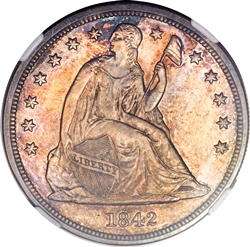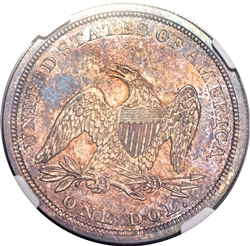 |
1842
 
 |
 |
General Comments
|
| |||||||||||||||||||||
High-grade business strikes are sometimes prooflike, but more often frosty. Prooflike and/or sharply struck examples can be located with patient searching.
1842 Die Marriages
Since the first edition of my book was published in January, 2018 a new die marriage has been discovered for 1842. I discovered this marriage while updating my review of auction archives in preparation for the publication of the second edition. This new marriage pairs a new obverse die, Obverse 8, with Reverse A. Obverse 8 is similar to Obverse 1, so much so that I missed two examples in my previous review of archived auction records (in late 2016). More will be said about the similarities in the detailed descriptions of OC-1 and OC-8.
9 die pairs have now been positively identified. 7 obverse dies were paired with 2 reverse dies to strike eight business strike die pairs. Three of these are rare. The other 5 can be easily located. None of these business strike dies were used for proofs.
A single proof die marriage was issued, using a unique obverse die paired with the reverse die used for almost all original proof issues from 1840 through 1854. I estimate a total surviving proof population of 15.
The following table summarizes the known die marriages for 1842:
Click the links below to view the details of each die marriage.
Die Marriage |
Rarity |
Obverse Die |
Reverse Die |
Estimated Survivors |
| OC-1 | R3 | 1 | A | 375 |
| OC-2 | R1 | 2 | A | 1625 |
| OC-3 | R2 | 3 | A | 1175 |
| OC-4 | R1 | 3 | B | 1300 |
| OC-5 | R5- | 4 | B | 70 |
| OC-6 | R6- | 5 | B | 30 |
| OC-7 | R2 | 6 | B | 925 |
| OC-8 | R5 | 7 | A | 50 |
| OC-P1 | R6+ | P1 | 1840 PA | 15 |
1842 Business Strike Emission Sequence
The 1842 emission sequence can be determined with reasonable accuracy since only two reverse dies were
used for the 8 die marriages. We have considerable confidence in the first 4 marriages in the sequence.
Reverse A, used for the first 4 die marriages, was polished several times, each time removing some of
the unfinished areas and die markers that are present in its initial state. By observing the reduction
in these areas, I was able to accurately determine the order of the first 4 marriages. Reverse A was
then retired and replaced with reverse B, without changing the obverse die, Obverse 3. Obverse 3
exhibits notable degradation during its use. In its early state significant unfinished areas are
notable, connecting both ends of the rock and the top of the head to the rims. As the die state
progresses these unfinished areas are removed by die polishing. In its final state light rim cuds
appear below the date. These are seen only on die marriage OC-4, which identifies that marriage as the
final use of Obverse 3. The sequence following OC-4 is more difficult. Reverse B showed virtually no
degradation during its use. The only change in state that Iíve observed is a small rim cud that appears
as state b. Iíve seen that state on only a single coin, so I would feel more comfortable if I saw
another example to confirm it. Iíve tentatively used it to place die marriage OC-7 at the end of the
sequence. Iíve made my best guess to determine the placement of the other two marriages. My estimate of
the emission sequence is documented in the following table.
Emission Order |
Die Marriage |
Comments |
| 1 | OC-1 | Unfinished areas of reverse A are reduced by die polishing in each of the first 3 die marriages. |
| 2 | OC-8 | |
| 3 | OC-2 | |
| 4 | OC-3 | |
| 5 | OC-4 | Obverse 3 rim cuds indicate that OC-4 followed OC-3. |
| 6 | OC-5 | |
| 7 | OC-6 | |
| 8 | OC-7 | The only pairing of reverse B state b (an observed but unconfirmed die state) indicates that OC-7 is the terminal die state for Reverse B. |
1842 Proof Emission Sequence
With only a single proof die marriage the emission sequence is simple.
Emission Order |
Die Marriage |
Comments |
| 1 | OC-P1 |
1842 Quick Finder Chart
1842 coins are relatively easy to attribute. Only 2 reverse dies were used. They can usually be easily identified
even on low-grade coins. 6 obverse dies were used, but the date positions are different. The best approach to
attribution is to first identify the reverse die, then choose from the obverse dies known to be paired with that
reverse the one which best fits your coin. This approach should allow quick attribution of almost any coin down
to a grade of VG.
Die Marriage |
Obv. Die |
Rev. Die |
Right Base of 1 |
1 Verticle |
2 Verticle |
Grid |
Keys to Identification |
| OC-1 | 1 | A | B | SH | SH | 4-5.0 | Obverse: Die lines from shield edge below Y. Die lines in field above right arm. Left-most date.
Reverse: 3 parallel die lines slant slightly down in upper left shield recess. |
| OC-2 | 2 | A | JR of C/JL of C | VSH | VSH | 5-5.0 | Obverse: Far right date, 5-5.0.
Reverse: 3 parallel die lines slant slightly down in upper left shield recess. |
| OC-3 | 3 | A | JL of RE | VSH | VSH | 5-2.0 | Obverse: Die lines parallel left arm above finger.
Reverse: 3 parallel die lines slant slightly down in upper left shield recess. |
| OC-4 | 3 | B | JL of RE | VSH | VSH | 5-2.0 | Obverse: Die lines parallel left arm above finger.
Reverse: 2-2 and 2-3 across first shield border at bottom. |
| OC-5 | 4 | B | L QTR | VSL | C | 5-2.5 | Obverse: Heavy die line above the bend of the right elbow.
Reverse: 2-2 and 2-3 across first shield border at bottom. |
| OC-6 | 5 | B | LE | C | SL | 5-5.5 | Obverse: Far right date, 5-5.5.
Reverse: 2-2 and 2-3 across first shield border at bottom. |
| OC-7 | 6 | B | B | SL | SL | 5-4.0 | Obverse: 2 in rock. Die lines above leg left of pole. Obverse cuds in late states.
Reverse: 2-2 and 2-3 across first shield border at bottom. |
| OC-8 | 7 | A | JR of LE | VSH | C | 5-1.0 | Obverse: Date position differs slightly from Obverse 1.
Reverse: 3 parallel die lines slant slightly down in upper left shield recess. |
| OC-P1 | P1 | 1840 PA | LE | C | VSL | 5-5.5 | Obverse: Repunched 1. 1 is centered. Date slants slightly down.
Reverse: Defects on A3. |
